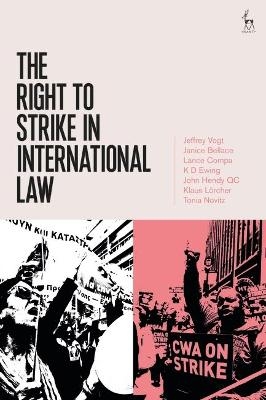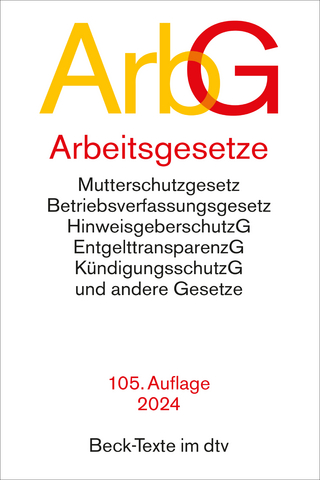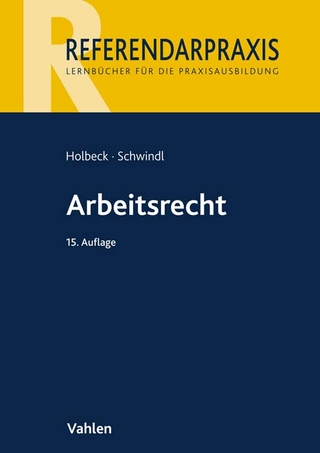
The Right to Strike in International Law
Hart Publishing (Verlag)
978-1-5099-3355-6 (ISBN)
The group’s apparent aim was to sow sufficient doubt as to the existence of an internationally protected right so that governments might seek to limit or prohibit the right to strike at the national level while still claiming compliance with their international obligations. In consequence, some governments have seized on the employers’ arguments to justify new limitations on that right.
The Right to Strike in International Law not merely refutes this claim but is the only complete and exhaustive analysis on this subject. Based on deep legal research, it finds that there is simply no credible basis for the claim that the right to strike does not enjoy the protection of international law; indeed, the authors demonstrate that it has attained the status of customary international law.
Jeffrey Vogt is Rule of Law Director, Solidarity Center. Janice Bellace is Samuel A Blank Professor Emeritus of Legal Studies and Business Ethics, University of Pennsylvania, Wharton. Lance Compa is Senior Lecturer at the School of Industrial and Labor Relations, Cornell University. K D Ewing is Professor of Public Law at King’s College London. Lord Hendy KC is a barrister at Old Square Chambers, London and Honorary Professor in the Faculty of Law, University College, London. Klaus Lörcher is former Legal Adviser to the European Trade Union Confederation and former Legal Secretary of the Civil Service Tribunal of the European Union. Tonia Novitz is Professor of Labour Law at the University of Bristol.
PART I
AN INTRODUCTION
1. Understanding the International Labour Organization (ILO)
I. An ILO Primer
2. The Ill-Founded Challenge to the Right to Strike in 2012
I. The Showdown at the 2012 International Labour Conference
II. Why Then?
III. And Now?
PART II
A REBUTTAL: ON THE QUESTION OF MANDATES
3. The ILO Committee of Experts has a Mandate to ‘Interpret’ ILO Conventions, not the Constituents
I. A Brief History
II. The Mandates of ILO Supervisory Bodies Establish No Hierarchy Among Them
III. The Committee of Experts and the Interpretation of Conventions
IV. Conclusion
PART III
A REBUTTAL: THE INDISPUTABLE CASE FOR THE RIGHT TO STRIKE
4. The Rules of Interpretation: The Vienna Convention on the Law of Treaties (VCLT)
I. Applicability of the VCLT
II. VCLT Rules of Interpretation as Customary International Law
III. ILO Practice
5. The Ordinary Meaning of Convention 87 Supports the Existence of a Right to Strike
6. The Object and Purpose of Convention 87 Supports the Existence of a Right to Strike
7. The Subsequent Agreement and Practice between the Parties Concerning Convention 87 Supports the Existence of a Right to Strike: ILO Jurisprudence
I. Some History
II. The Right to Strike is Enshrined in Convention 87
III. The ILO Constitution
IV. The Right to Strike in Subsequent ILO Instruments
V. 2015 Tripartite Meeting on the Right to Strike
8. The Subsequent Agreement and Practice between the Parties Concerning Convention 87 Supports the Existence of a Right to Strike: Beyond the ILO
I. United Nations
II. Council of Europe Instruments
III. The Right to Strike and the European Union
IV. The Inter-American System
V. African Charter on Human and Peoples’ Rights
VI. The Right to Strike and Trade Arrangements
VII. High Court Cases Since 2012 Affirm the Right to Strike
9. Other Methods under Article 31 of the Vienna Convention on the Law of Treaties (VCLT) Support the Existence of the Right to Strike
I. ‘Any Relevant Rules of International Law Applicable in the Relations between the Parties’ (Article 31(3)(c) VCLT)
II. ‘A Special Meaning Shall be Given to a Term if it is Established that the Parties So Intended’ (Article 31(4) VCLT)
III. Further Interpretation Principles
IV. Inadmissible ‘Creative Interpretation’?
10. Though Unwarranted, Article 32 of the Vienna Convention on the Law of Treaties (VCLT) also Supports the Existence of the Right to Strike
I. Resort to the Preparatory Work of Convention 87 is Unwarranted
II. Application of Article 32 VCLT would Not Affect the Outcome were it Applied
11. The Right to Strike is Recognised as Customary International Law
I. The United Nations
II. The ILO
III. National Constitutions
IV. Legislation
V. Judicial Opinion
VI. Conclusion
PART IV
WHERE TO FROM HERE?
12. Settling the Dispute: The International Court of Justice?
13. The Aftermath
I. Impact on ILO Supervisory System
II. The Impact Outside the ILO
14. Conclusion
I. The Return of the Strike
| Erscheinungsdatum | 11.03.2020 |
|---|---|
| Verlagsort | Oxford |
| Sprache | englisch |
| Maße | 156 x 234 mm |
| Gewicht | 553 g |
| Themenwelt | Recht / Steuern ► Arbeits- / Sozialrecht ► Arbeitsrecht |
| Recht / Steuern ► EU / Internationales Recht | |
| Recht / Steuern ► Öffentliches Recht ► Völkerrecht | |
| ISBN-10 | 1-5099-3355-7 / 1509933557 |
| ISBN-13 | 978-1-5099-3355-6 / 9781509933556 |
| Zustand | Neuware |
| Haben Sie eine Frage zum Produkt? |
aus dem Bereich


